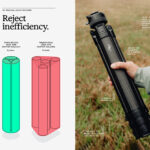The sun is shining, there’s a blue sky and a gentle breeze as you stroll leisurely through your favorite countryside location. You perceive a faint trickle of moving water in the distance, and as you move closer, you notice a winding stream. The water is dancing across the stones lying in the shallow stream. You have your camera poised, realizing this is a classic opportunity to take something really wonderful. But just how do you make moving water look amazing in a photograph? This article explains some digital photography tricks to employ to make the most of this and similar situations.
To start with, to be truly creative you will need to move away from using your automatic camera settings. Whilst the camera will do its best to capture what it thinks you want, it is possible that it will choose a fast shutter speed in order to “freeze” the movement. If that’s what you want to depict, then OK. But the more dramatic pictures are those where water motion is evident, and the rest of the picture is still.
A slow shutter speed will need to be chosen to show the motion of the water. The slower your shutter speed the greater the motion captured. I suggest you experiment. After a shot immediately check the results on your LCD screen. Then adjust, to a slower or faster shutter speed, until you get the shot you want. To achieve optimum results will require a shutter speed of at least 1/15 of a second, or longer. Truly smooth water should be captured if you leave the shutter open for over a second.
Using a slow shutter speed will mean that your camera needs to be absolutely still to avoid camera shake ruining the picture. The best way to establish a stable platform is to use a tripod. Another trick is to add a shutter release cable, giving you the greatest chance of eliminating camera movement during your shot. Also, set your ISO to about 100, with a small aperture of around f/22. A small aperture results in the slowest possible shutter speed for the ISO and light conditions.
Try using a photography trick from this list:
- Get fairly close to the water you want to shoot. The blurring effect of the moving water is more noticeable if you are close up.
- Experiment by photographing different types of moving water scenes (waterfalls, rivers, streams, etc.).
- Revisit locations at different times of year to capture how nature has changed the look of them.
- If brightly-lit conditions affect the length of shutter speed you can use, consider the addition of a polarizing or neutral density filter.
You can discover the secrets of taking stunning photographs, simply by adding a few digital photography tricks. Please check out http://www.photographycourseonline.info for further information.
Like This Article?
Don't Miss The Next One!
Join over 100,000 photographers of all experience levels who receive our free photography tips and articles to stay current:








I like how you said to use a slow shutter to capture the movement of the water. Unfortunately, I don’t have the equipment to take awesome water pictures. Maybe hiring a professional who has experience with water shots can get me some good surfing pictures of my son.
I took a movie of the stream, is there now away to get the save effect as seen in the photos above
I always saw photographing moving water and freezing it as a form of art and appreciated those mates who made all those stunning pictures.
Nice article and tips… Thanks for sharing.
I had tried couple years ago to shot water motion. Love to take “silky water”.
Link > https://picasaweb.google.com/lh/photo/oCL0jlGMszKtkvFC0fvPcdMTjNZETYmyPJy0liipFm0?feat=directlink
I love capturing water in motion but it is difficult with out a tripod and if you just happen to come up along a stream most likely I won’t have a tripod with me. If the moving water isn’t far you can always come back with the tripod and get a great shot.